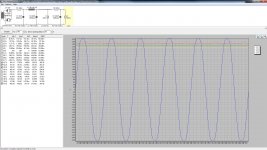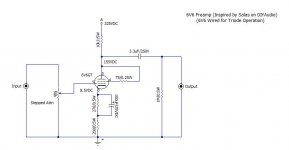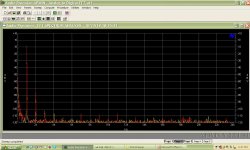I hate to ask but could a person use several 150vdc 0D3 regulator tubes in series instead of a shunt regulator?
Any good and proven PSU solution will work well, there will be some subjective differences with each one of course. But in general the main circuit keeps its character.
Hello All,
Here is my version of Salas's 6V6 preamp (gain version) that I put together.
Power supplies (filament and plate) are very quiet and performance seems reasonable for not being buffered.
I have it connected to a 2A3 stereo amp (that I also built) with ported Klipsch LaScala's. If I place my ear to the LaScala tweeter, I can barely hear a faint hiss.
The design was mainly dictated by an old 6SN7 preamp chassis that I had on hand. It was a fairly easy conversion. I want to ultimately use a pair of Edcor GXSE5-15K (Primary), Secondary (Output) Impedance: 600 Ω instead of the cap coupled output.
Here is my version of Salas's 6V6 preamp (gain version) that I put together.
Power supplies (filament and plate) are very quiet and performance seems reasonable for not being buffered.
I have it connected to a 2A3 stereo amp (that I also built) with ported Klipsch LaScala's. If I place my ear to the LaScala tweeter, I can barely hear a faint hiss.
The design was mainly dictated by an old 6SN7 preamp chassis that I had on hand. It was a fairly easy conversion. I want to ultimately use a pair of Edcor GXSE5-15K (Primary), Secondary (Output) Impedance: 600 Ω instead of the cap coupled output.
Attachments
Some data from my Audio Precision (AP). The frequency difference between channels may be a component (or wiring) I am using. When I switch tubes, the disparity remains in the same channel. I'll figure it out eventually.
- Signal to Noise bandwidth is 400Hz to 80kHz.
- Signal to Noise is un-weighted.
There is an issue with my weighted AP filter that I need to resolve, which is why there is only un-weighted data.
A cathode follower or step-down transformer would help extend the frequency response and allow the preamp to drive just about any load without frequency anomalies.
A few pix of my preamp test bed. Not pretty, but it is good for proof of concept projects.
- Signal to Noise bandwidth is 400Hz to 80kHz.
- Signal to Noise is un-weighted.
There is an issue with my weighted AP filter that I need to resolve, which is why there is only un-weighted data.
A cathode follower or step-down transformer would help extend the frequency response and allow the preamp to drive just about any load without frequency anomalies.
A few pix of my preamp test bed. Not pretty, but it is good for proof of concept projects.
Attachments
-
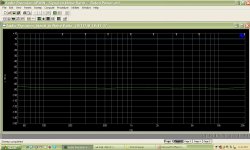 Signal to Noise_Unweighted_Full Power.jpg148.1 KB · Views: 126
Signal to Noise_Unweighted_Full Power.jpg148.1 KB · Views: 126 -
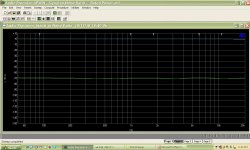 Signal to Noise_Unweighted_Unity Gain.jpg147 KB · Views: 123
Signal to Noise_Unweighted_Unity Gain.jpg147 KB · Views: 123 -
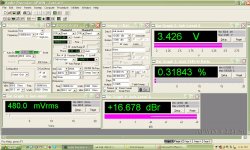 Left Analyzer Panel_Full Gain.jpg217.9 KB · Views: 107
Left Analyzer Panel_Full Gain.jpg217.9 KB · Views: 107 -
 Right Analyzer Panel_Unity Gain.jpg214.5 KB · Views: 552
Right Analyzer Panel_Unity Gain.jpg214.5 KB · Views: 552 -
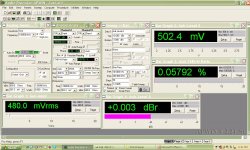 Left Analyzer Panel_Unity Gain.jpg215 KB · Views: 570
Left Analyzer Panel_Unity Gain.jpg215 KB · Views: 570 -
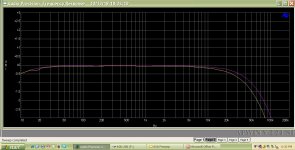 Frequency Response_Full Gain.jpg124.7 KB · Views: 566
Frequency Response_Full Gain.jpg124.7 KB · Views: 566 -
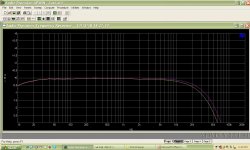 Frequency Response_Unity Gain.jpg152 KB · Views: 590
Frequency Response_Unity Gain.jpg152 KB · Views: 590 -
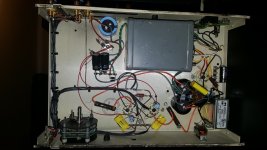 6V6 Preamp Test Bed.jpg214.1 KB · Views: 201
6V6 Preamp Test Bed.jpg214.1 KB · Views: 201 -
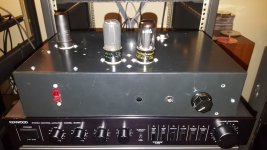 6V6 Preamp Test Bed_2.jpg193.8 KB · Views: 210
6V6 Preamp Test Bed_2.jpg193.8 KB · Views: 210
Last edited:
Congrats. Nice presentation and testing. You opted for 10k plate load instead of 5k I see. That gives better THD but more Zo. Its a fair trade off when the load permits.
The -3dB HF response can be extended with a lower value pot. Maybe the 100kHz to 80kHz response difference between channels in the curves has something to do with the pot's output resistance and unequal pF to the grid. Wiring, bases, pot decks, could affect. That would give different Miller and RC time.
Ultimately, if you don't strictly need voltage gain, the cathode follower version offers better extension and general spec. Tx output instead is good also, at least for SNR and Zo. The Tx has its own response and THD spec to mix in. You could rather easily try both and decide.
The CF (buffer) version is not inverting of course so remember that during comparisons with an inverting version. Just swap the speaker leads between red and black at the cabinet's binding posts to restore absolute phase for the inverting one.
How did you like it vs the 6SN7 pre you had by the way?
The -3dB HF response can be extended with a lower value pot. Maybe the 100kHz to 80kHz response difference between channels in the curves has something to do with the pot's output resistance and unequal pF to the grid. Wiring, bases, pot decks, could affect. That would give different Miller and RC time.
Ultimately, if you don't strictly need voltage gain, the cathode follower version offers better extension and general spec. Tx output instead is good also, at least for SNR and Zo. The Tx has its own response and THD spec to mix in. You could rather easily try both and decide.
The CF (buffer) version is not inverting of course so remember that during comparisons with an inverting version. Just swap the speaker leads between red and black at the cabinet's binding posts to restore absolute phase for the inverting one.
How did you like it vs the 6SN7 pre you had by the way?
The 6SN7 preamp had more gain than I needed. It also had more noise.
Overall, I believe this 6V6 version will suite my needs better (especially after the transformer conversion). The 6V6 sound and performance seem to be a perfect compliment for my listening tastes.
Forgot to mention... the 6V6 is microphonic, but I'll address that in the final build project by isolating the tube sockets. I have some 6V6 metal tubes which measure and sound good, but seem to be the most microphonic.
Attached is the power supply simulation for reference. The power supply can be fairly simple, but still low noise. I'm usually a fan of simple, but high performance. I don't like to make things overly complicated, from a sonic standpoint and service.
Overall, I believe this 6V6 version will suite my needs better (especially after the transformer conversion). The 6V6 sound and performance seem to be a perfect compliment for my listening tastes.
Forgot to mention... the 6V6 is microphonic, but I'll address that in the final build project by isolating the tube sockets. I have some 6V6 metal tubes which measure and sound good, but seem to be the most microphonic.
Attached is the power supply simulation for reference. The power supply can be fairly simple, but still low noise. I'm usually a fan of simple, but high performance. I don't like to make things overly complicated, from a sonic standpoint and service.
Attachments
Last edited:
Yes it is mechanically sensitive since its a bigger bottle designed for power output and to be stepped down. That's not too pronounced in the cathode follower form but it has to be addressed in the common cathode. Tube makes and vintages differ for that sensitivity. Modern reissue like the Russian "Tungsol" was rather good in that. People have used extensive elastic decoupling sometimes. One had used spring mounted sub-chassis even. Its true I promoted an unorthodox 6V6 use, and that has to have some practical side effects, but the sound is good.
If you can step down your now gain to some happy compromise between the voltage gain your audio system really needs and the tubes microphonics, you will have a lower level problem to mechanically deal with.
Its alright when you got the iron i.e. good high value choke that won't saturate loaded with two 6V6's current bias.
If you can step down your now gain to some happy compromise between the voltage gain your audio system really needs and the tubes microphonics, you will have a lower level problem to mechanically deal with.
Attached is the power supply simulation for reference. The power supply can be fairly simple, but still low noise. I'm usually a fan of simple, but high performance. I don't like to make things overly complicated, from a sonic standpoint and service.
Its alright when you got the iron i.e. good high value choke that won't saturate loaded with two 6V6's current bias.
I added a very small amount of current feedback to reduce the gain a bit (about 1.6dB or 0.5VRMS reduction). The gain structure is perfect now for my taste and equipment.
Although I can't measure it, the residual noise structure is now "quieter". Before feedback, with my ear to the tweeter, I could hear faint "popcorn" noise, now it is just a faint hiss.
Although I can't measure it, the residual noise structure is now "quieter". Before feedback, with my ear to the tweeter, I could hear faint "popcorn" noise, now it is just a faint hiss.
Attachments
Spice says 0.03125% THD (not +N) at 1kHz 9.8dBV out* for the above circuit, seems optimistic
For bias point it says 8.22V and 17.48mA at the cathode, the model is very close at least for that
*0.5VRMS in 3.1VRMS out (pot at max, gain X6.2)
For bias point it says 8.22V and 17.48mA at the cathode, the model is very close at least for that
*0.5VRMS in 3.1VRMS out (pot at max, gain X6.2)
For 450mVRMS in, I am getting 2.7xxVRMS out (no load).
Listening to Vivaldi Four Seasons right now. Sounds great.
Listening to Vivaldi Four Seasons right now. Sounds great.
So your real gain is X6 vs X6.2 modeled, not bad, within tube μ variation error
Yes, its nice SQ, the purpose was to touch some DHT triode qualities but with an easier indirectly heated and ubiquitous model. Those genuine triode directly heated bulbs when in same role are microphonic too by the way.
Yes, its nice SQ, the purpose was to touch some DHT triode qualities but with an easier indirectly heated and ubiquitous model. Those genuine triode directly heated bulbs when in same role are microphonic too by the way.
Unless you play the test signal on the speakers at a loud level back at it while running the FFT or the mains transformer had a mechanical hum they could pick up via the chassis, no worries 🙂
Has anyone built a version with the 6AQ5, or 6P1P? I'm curious if the microphonics are lessened from the smaller package. The 6P1P sure is affordable enough.
You're right Salas.
I have 10 6V6's of various vintage... the 2 that are in the preamp now are NOS, a Sylvania (gray glass) and a Westinghouse (top getter). These particular tubes are "acceptable" regarding microphonics. The desire to isolate the tubes from the chassis is becoming less of an issue after realizing the microphonics are not that big of a deal.
Gain error between channels is < 0.1dB
I have 10 6V6's of various vintage... the 2 that are in the preamp now are NOS, a Sylvania (gray glass) and a Westinghouse (top getter). These particular tubes are "acceptable" regarding microphonics. The desire to isolate the tubes from the chassis is becoming less of an issue after realizing the microphonics are not that big of a deal.
Gain error between channels is < 0.1dB
I just thought of a crude practical test. Connect the preamp's output to the scope at 1mS & 5mV/div or less, let it idle with no input signal. Then go over and yell at it from a short distance as you watch the scope. If it will not mess the screen with too high jumping noises it should be alright 😀
Has anyone built a version with the 6AQ5, or 6P1P? I'm curious if the microphonics are lessened from the smaller package. The 6P1P sure is affordable enough.
There has been some question about building it with the 6AQ5 in the past and I said go for it but I can't remember a build. I had also mentioned the possibility of the English 6BW6 early in the thread. I don't know if it would be subjectively identical to using a good 6V6 but it has chances to be close.
- Home
- Amplifiers
- Tubes / Valves
- 6V6 line preamp

